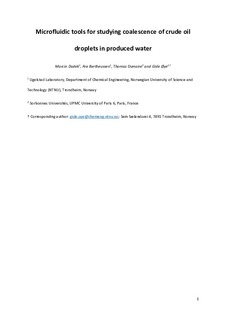| dc.contributor.author | Dudek, Marcin | |
| dc.contributor.author | Bertheussen, Are | |
| dc.contributor.author | Dumaire, Thomas | |
| dc.contributor.author | Øye, Gisle | |
| dc.date.accessioned | 2018-08-08T11:02:26Z | |
| dc.date.available | 2018-08-08T11:02:26Z | |
| dc.date.created | 2018-08-02T08:27:24Z | |
| dc.date.issued | 2018 | |
| dc.identifier.citation | Chemical Engineering Science. 2018, 191 448-458. | nb_NO |
| dc.identifier.issn | 0009-2509 | |
| dc.identifier.uri | http://hdl.handle.net/11250/2508036 | |
| dc.description.abstract | The major contaminant targeted during the treatment of the oilfield produced water is dispersed oil. The efficiency of most separation processes highly relies on the size of the droplets, which can be increased through coalescence. Crude oil has a complex and field-dependent composition, which can affect the interfacial properties of the drops, and consequently the merging process in different ways. This study focused on the development of microfluidic techniques for investigating coalescence between crude oil drops. The experiments were performed with six diluted crude oils and three neat oils, the latter in the presence of an oil-soluble surfactant. The composition of the water phase was systematically varied (pH, ionic composition, presence of dissolved components). In general, crude oil droplets coalesced more readily in lower or neutral pH. The addition of dissolved Fluka acids to the water phase had a unique effect on each crude oil, reflecting their composition. What is more, this effect was similar to the presence of water-soluble crude oil components in the aqueous phase. The pressure did not have a significant effect on the coalescence, which was explained by the lack of the lightest components (C1-C4) in the system. In summary, the results revealed several trends, however it was clear that the coalescence highly depended on the oil composition. This underlined the necessity for experimental methods, such as microfluidics, which allow for quick assessment of the stability of crude oil droplets. | nb_NO |
| dc.language.iso | eng | nb_NO |
| dc.publisher | Elsevier | nb_NO |
| dc.rights | Attribution-NonCommercial-NoDerivatives 4.0 Internasjonal | * |
| dc.rights.uri | http://creativecommons.org/licenses/by-nc-nd/4.0/deed.no | * |
| dc.title | Microfluidic tools for studying coalescence of crude oil droplets in produced water | nb_NO |
| dc.type | Journal article | nb_NO |
| dc.type | Peer reviewed | nb_NO |
| dc.description.version | acceptedVersion | nb_NO |
| dc.source.pagenumber | 448-458 | nb_NO |
| dc.source.volume | 191 | nb_NO |
| dc.source.journal | Chemical Engineering Science | nb_NO |
| dc.identifier.doi | 10.1016/j.ces.2018.07.006 | |
| dc.identifier.cristin | 1599424 | |
| dc.description.localcode | © 2018. This is the authors’ accepted and refereed manuscript to the article. Locked until 4.7.2020 due to copyright restrictions. This manuscript version is made available under the CC-BY-NC-ND 4.0 license http://creativecommons.org/licenses/by-nc-nd/4.0/ | nb_NO |
| cristin.unitcode | 194,66,30,0 | |
| cristin.unitname | Institutt for kjemisk prosessteknologi | |
| cristin.ispublished | true | |
| cristin.fulltext | preprint | |
| cristin.qualitycode | 2 | |

